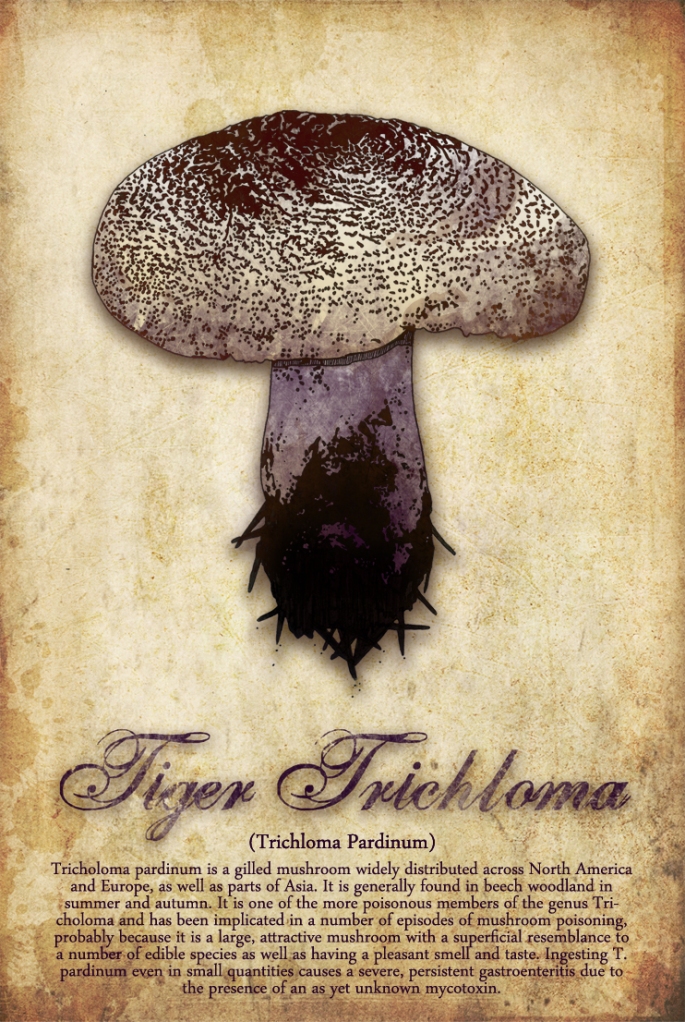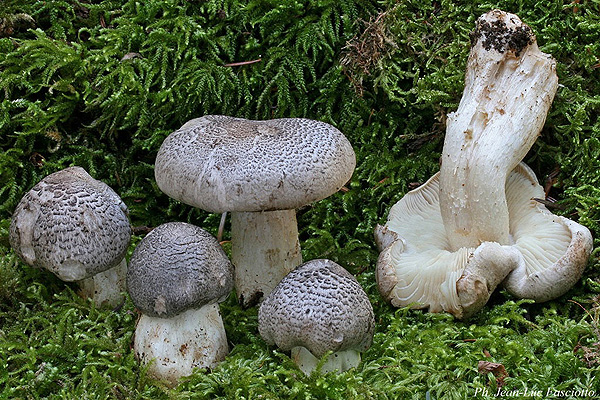
Tricholoma pardinum, commonly known as spotted tricholoma, tiger tricholoma, tigertop, leopard knight, or dirty trich
Available as a print, poster, pillow and more on Society6
“Tricholoma pardinum, commonly known as spotted tricholoma, tiger tricholoma, tigertop, leopard knight, or dirty trich, is a gilled mushroomwidely distributed across North America and Europe, as well as parts of Asia. It is generally found in beech woodland in summer and autumn. Two subspecieshave been described from southern Europe.”
“Tricholoma pardinum is one of several poisonous members of the genus Tricholoma; its large size, fleshy appearance, and pleasant smell and taste add to the risk of it being accidentally consumed. It was responsible for over 20 percent of cases of mushroom poisoning in Switzerland in the first half of the 20th century. Many cases of poisoning arise in the Jura Mountains. Eating it causes highly unpleasant gastrointestinal symptoms of nausea, dizziness, vomiting, and diarrhea. These arise 15 minutes to 2 hours after consumption and often persist for several hours; complete recovery usually takes 4 to 6 days. Sweating and anxiety may be evident, and disturbance in liver function has been recorded. Cramping may occur in the calves. In one case, seven people and a cat suffered severe symptoms after sharing a meal that contained only two mushroom caps. The toxin, the identity of which is unknown, appears to cause a sudden inflammation of themucous membranes lining the stomach and intestines.
These symptoms may be severe enough to warrant hospitalisation. Treatment is supportive; antispasmodic medicines may lessen colicky abdominal cramps, and activated charcoal may be administered early on to bind residual toxin. Intravenous fluids may be required if dehydration has been extensive, especially with children and the elderly. Once gastric contents are emptied, metoclopramide may be used in cases of recurrent vomiting.” – Wikipedia
The Debate
“There has been much debate over the authority for this species, and even after two centuries of arguing disagreement still springs up sporadically. Although this mushroom was described scientifically in 1801 by Christiaan Hendrik Persoon it is clear that others who recorded this species before him also have claims worthy of consideration. Jacob Christian Schaeffer was one such, as also was the Swiss mycologist Louis Gabriel Abraam Samuel Jean Secretan (1758 – 1839). Although Secretan was a lawyer he seems to have had little regard for the rules of botanical naming; as a result names that he allocated are generally invalid unless they have been subsequently republished by other authors.
The widely accepted scientific name Tricholoma pardinum dates from an 1873 publication by the French mycologist Lucien Quélet.
In his 1762 publication Fungorum qui in Bavaria et Palatinatu circa Ratisbonam nascuntur icones, nativis coloribus expressae, Jacob Christian Schaeffer included an illustration (left) of a mushroom that looks very much like Tricholoma pardinum, although his scientific description of the species was rather less clear. Schaeffer called this mushroom Agaricus tigrins (at a time when most gilled fungi were placed in the genus Agaricus, since largely redistributed across many new genera), which might therefore be considered as synonymous with Tricholoma pardinum; however, the specific epithet tigrinus is invalid because it has been allocated to Lentinus tigrinis, a gilled honorary member of the family Polyporaceae.” – First Nature
